If you want to know how to get big quads, I have good and bad news.
The good news is that building big quads isn’t complicated.
The bad news is that it also isn’t easy. You’re going to be wobbling around like a baby deer on bath salts after some of these quad workouts.
First and foremost, you need to squat—and you need to squat heavy.
Beyond that, building bigger thighs comes down to doing just a handful of simple, time-tested quad exercises, coupled with the right amount of volume, and a willingness to train hard—for weeks and months.
And one more thing: If someone says the best quad workouts involve a TRX, Bosu ball, or bodyweight squats, ignore them. They’re just plain wrong. Your fastest and most effective way to build bigger thighs is with the kind of barbell exercises and workouts you’ll learn about in this article.
In this article you’re going to learn everything you need to know about how to get big quads, including the best quad exercises there are, the best quad workout you can do for mass, and more!
Best Quad Workout for Mass
Barbell Back Squat: 3 sets of 4-to-6 reps with 2-to-3 min rest
Leg Press: 3 sets of 8-to-12 reps with 2-to-3 min rest
Leg Extension: 3 sets of 8-to-12 reps with 2-to-3 min rest
Dumbbell Bulgarian Split Squat: 3 sets of 8-to-12 reps with 2-to-3 min rest
This is the absolute best quad workout you can do.
It starts with the king of all quad exercises—the barbell back squat—and the rest of the exercises are quad-dominant compound exercises to help you lift as heavy as possible. Your quads will get 12 hard sets of training in this workout, which is enough to kick muscle growth into high gear without interfering with your recovery.
If you’re worried that focusing so heavily on your quads might leave your hamstrings behind, add in some Romanian deadlifts or leg curls to the end of your workout to balance things out.
Best Quad Exercises for Mass
Barbell Back Squat
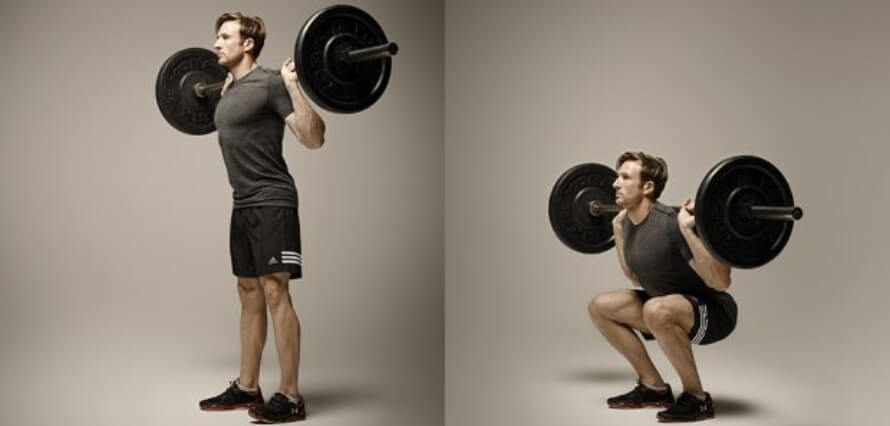
Sets: 3 | Reps: 4 to 6 | Rest: 2 to 3 min
How to: Position a barbell in a squat rack at about the height of your breast bone. Step under the bar, pinch your shoulder blades together, and rest the bar directly above the bony ridges on the bottom of your shoulder blades. Lift the bar out of the rack, take one or two steps backward, and place your feet a little wider than shoulder-width apart with your toes pointing slightly outward. Sit down and remember to keep your back straight and push your knees out in the same direction as your toes throughout each rep. Stand up and return to the starting position.
Why: The barbell back squat is hands down the most effective leg exercise you can do for building overall size and strength. It also allows you to use heavy weight, which means it’s ideal for gaining quad size and strength.
Leg Press

Sets: 3 | Reps: 8 to 12 | Rest: 2 to 3 min
How to: Load a leg press with plates and adjust the seat to its lowest position (with the backrest closest to the floor, at about a 30-degree angle). Then sit in the leg press seat, and wedge your butt down into the base of the seat.
Place your feet halfway up the footplate a little wider that shoulder-width apart with your toes pointing slightly outward. Bend your knees slightly and use the safety handles to release the weight. Lower the footplate toward your chest until your thighs are at a 90-degree angle to your torso while keeping your butt firmly planted in the seat and without rounding your back. Next, push the footplate upward until your legs are almost but not completely straight (knees slightly bent). Repeat the movement for the desired number of reps.
Why: The leg press doesn’t require any balance and you don’t have to support any weight on your back. This means you can lift much heavier loads than you would be able to with a free weight exercise like the back squat. It’s also far less fatiguing than exercises like squats, so you can do it more often without burning out. While it’s no replacement for the barbell back squat, it’s an outstanding accessory exercise.
Leg Extension
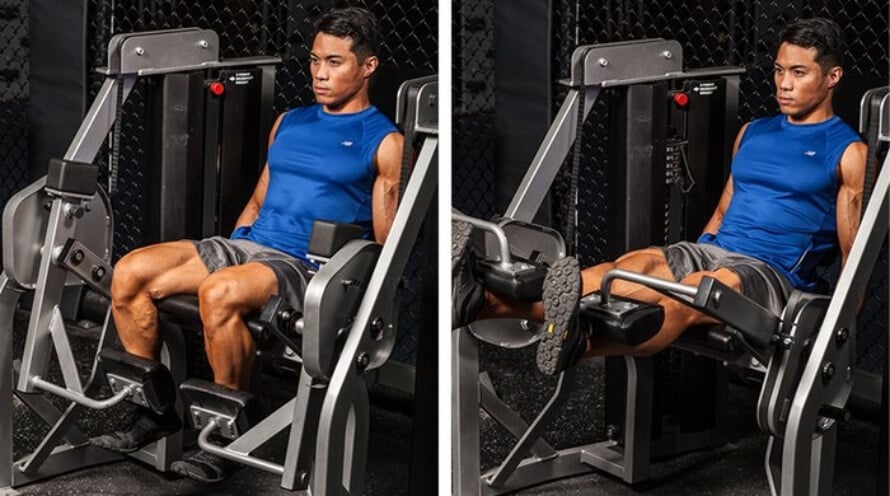
Sets: 3 | Reps: 8 to 12 | Rest: 2 to 3 min
How to: Adjust the back pad so that your knees are just in front of the edge of the seat when you’re seated. Then adjust the leg pad closest to the floor so it touches your shins right above your ankles and puts your feet as close to your butt as possible. Grab the handles, push your feet toward the ceiling until your legs are straight, then lower your feet, and return to the starting position.
Why: The leg extension enables you to train your quads in isolation. This means you can continue to train your quads using the leg extension even when the rest of your body is tired from doing lots of heavy, compound lifting.
Dumbbell Bulgarian Split Squat
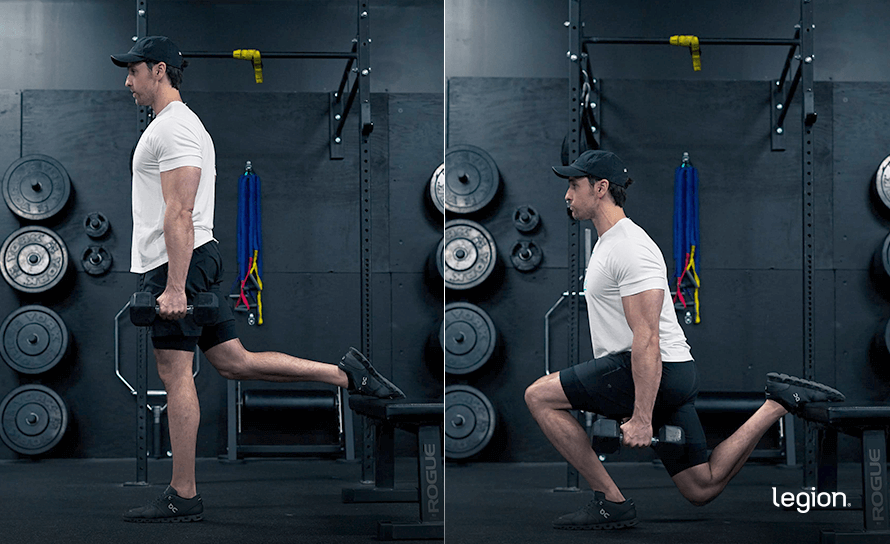
Sets: 3 | Reps: 8 to 12 | Rest: 2 to 3 min
How to: While holding a dumbbell in each hand, stand about two-to-three feet in front of a bench. With your right foot (and heel in particular) firmly planted, place the top of your left foot on the bench behind you. Look at a spot on the floor six-to-ten feet in front of you and lower your butt toward the floor by bending at your right knee. Keep lowering yourself until your right thigh is roughly parallel with the floor. Stand up and return to the starting position.
Why: Research shows that the dumbbell Bulagrian split squat is a great exercise for training the quads. Because the Bulgarian split squat trains just one leg at a time, it’s particularly useful for identifying and evening out any strength or muscle imbalances you might have, too.
Barbell Front Squat
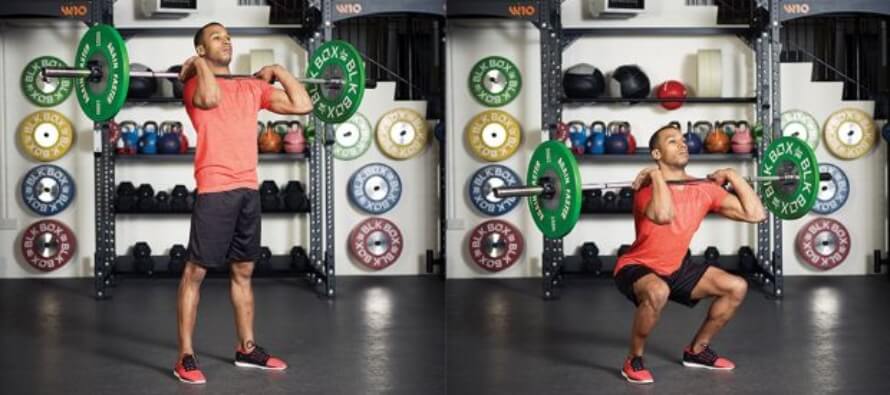
Sets: 3 | Reps: 8 to 10 | Rest: 2 to 3 min
How to: Position a barbell in a squat rack at about the height of your breast bone. Grab the bar with a shoulder-width grip and your palms facing away from you. Step closer to the bar so that it presses against the top of your breast bone and push your elbows up and out in front of the bar. With the bar resting on the front of your shoulders and held in place by your hands, lift it out of the rack, take one or two steps backward, and place your feet a little wider than shoulder-width apart with your toes pointing slightly outward. Sit down and remember to keep your back straight, elbows up, and push your knees out in the same direction as your toes throughout each rep. Stand up and return to the starting position.
Why: Research shows that the front squat trains the quads just as effectively as the back squat, even when you use up to 20% less weight. What’s more, research also shows that the front squat places considerably less compressive forces on your knees and lower back, which make it a particularly good alternative to back squats for people who have knee or back issues.
Goblet Squat
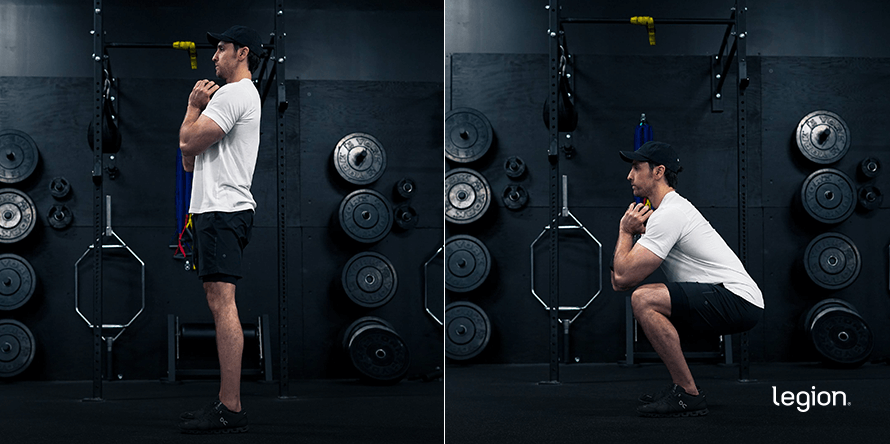
Sets: 3 | Reps: 10 to 20 | Rest: 2 to 3 min
How to: Stand up straight with your feet slightly wider than shoulder-width apart with your toes turned slightly out, and hold a dumbbell vertically against your chest. While keeping your back straight, squat down until your thighs are parallel with the ground. Stand up and return to the starting position. Remember to push your knees out in the same direction as your toes throughout each rep.
Why: The dumbbell goblet squat is a fantastic exercise for training all the major leg muscles, particularly the quads. The goblet squat also strengthens your upper- and lower-back muscles and improves your balance and coordination.
4 Tips for Bigger Quads
1. Once you hit the top of your rep range for one set, move up in weight.
For instance, if you squat 135 pounds for 6 reps on your first 4-to-6-rep set, you then add 5 pounds to each side of the bar for your next set.
If, on the next set, you can get at least 4 reps with 145 pounds, that’s the new weight you work with until you can squat it for 6 reps, move up, and so forth.
If you get 3 or fewer reps, though, reduce the weight added by 5 pounds (140 pounds) and see how the next set goes. If you still get 3 reps or fewer, reduce the weight to the original 6-rep load (135 pounds) and work with that until you can do two 6-rep sets with it, and then increase the weight on the bar.
This method is known as double progression, which you can learn about in this podcast:
How to Use Double Progression to Get More From Your Workouts
2. Rest at least 2-to-3 minutes between sets.
In most cases, this should give your muscles enough time to fully recoup their strength so you can give maximum effort each set.
That said, if you’re feeling gassed between heavy sets of big, compound exercises like the squat or leg press, it’s probably best to take a little longer—anywhere between 3 and 5 minutes should do the trick.
If you want to learn more about how long you should rest between sets, check out this article:
How Long Should You Rest Between Sets to Gain Muscle and Strength?
3. Eat enough calories and protein.
In order to maximize muscle and strength gain, you need to maintain a mild calorie surplus.
That is, you need to eat about 110% of your total daily energy expenditure (TDEE) every day. The reason for this is a calorie surplus optimizes your body’s “muscle-building machinery,” so to speak, greatly enhancing your body’s ability to recover from and positively adapt to your training.
That’s not all, though—you need to eat enough protein to allow your muscles to recover, repair, and grow effectively, too.
If you want to learn exactly how much protein you need to eat to build mass, check out this article:
How Much Protein Do I Need? The Definitive (and Science-Based) Answer
4. Take the right supplements.
I saved this for last because it’s the least important.
Unfortunately, no amount of pills and powders are going to automagically make your quads bigger. In fact, most muscle-building supplements are completely worthless.
But here’s the good news:
If you know how to eat and train to build muscle—following the steps we just covered—certain supplements can speed up the process. (And if you’d like to know exactly what supplements to take to reach your fitness goals, take the Legion Supplement Finder Quiz.)
Here are the best supplements for building bigger quads:
- 0.8-to-1.2 grams of protein per pound of body weight per day. This provides your body with the “building blocks” it needs to build and repair muscle tissue and help you recover from your workouts. If you want a clean, convenient, and delicious source of protein, try Whey+.
- 3-to-5 grams of creatine per day. This will boost muscle and strength gain, improve anaerobic endurance, and reduce muscle damage and soreness from your quad workouts. If you want a 100% natural source of creatine that also includes two other ingredients that will help boost muscle growth and improve recovery, try Recharge.
- One serving of Pulse per day. Pulse is a 100% natural pre-workout drink that enhances energy, mood, and focus; increases strength and endurance; and reduces fatigue. You can also get Pulse with caffeine or without.
Scientific References +
- Stokes, T., Hector, A. J., Morton, R. W., McGlory, C., & Phillips, S. M. (2018). Recent perspectives regarding the role of dietary protein for the promotion of muscle hypertrophy with resistance exercise training. In Nutrients (Vol. 10, Issue 2). MDPI AG. https://doi.org/10.3390/nu10020180
- Helms, E. R., Aragon, A. A., & Fitschen, P. J. (2014). Evidence-based recommendations for natural bodybuilding contest preparation: Nutrition and supplementation. In Journal of the International Society of Sports Nutrition (Vol. 11, Issue 1, p. 20). BioMed Central Ltd. https://doi.org/10.1186/1550-2783-11-20
- Schoenfeld, B. J., Pope, Z. K., Benik, F. M., Hester, G. M., Sellers, J., Nooner, J. L., Schnaiter, J. A., Bond-Williams, K. E., Carter, A. S., Ross, C. L., Just, B. L., Henselmans, M., & Krieger, J. W. (2016). Longer interset rest periods enhance muscle strength and hypertrophy in resistance-trained men. Journal of Strength and Conditioning Research, 30(7), 1805–1812. https://doi.org/10.1519/JSC.0000000000001272
- Gullett, J. C., Tillman, M. D., Gutierrez, G. M., & Chow, J. W. (2009). A biomechanical comparison of back and front squats in healthy trained individuals. Journal of Strength and Conditioning Research, 23(1), 284–292. https://doi.org/10.1519/JSC.0b013e31818546bb
- Yavuz, H. U., Erdağ, D., Amca, A. M., & Aritan, S. (2015). Kinematic and EMG activities during front and back squat variations in maximum loads. Journal of Sports Sciences, 33(10), 1058–1066. https://doi.org/10.1080/02640414.2014.984240
- Slater, L. V., & Hart, J. M. (2017). Muscle Activation Patterns during Different Squat Techniques. Journal of Strength and Conditioning Research, 31(3), 667–676. https://doi.org/10.1519/JSC.0000000000001323










